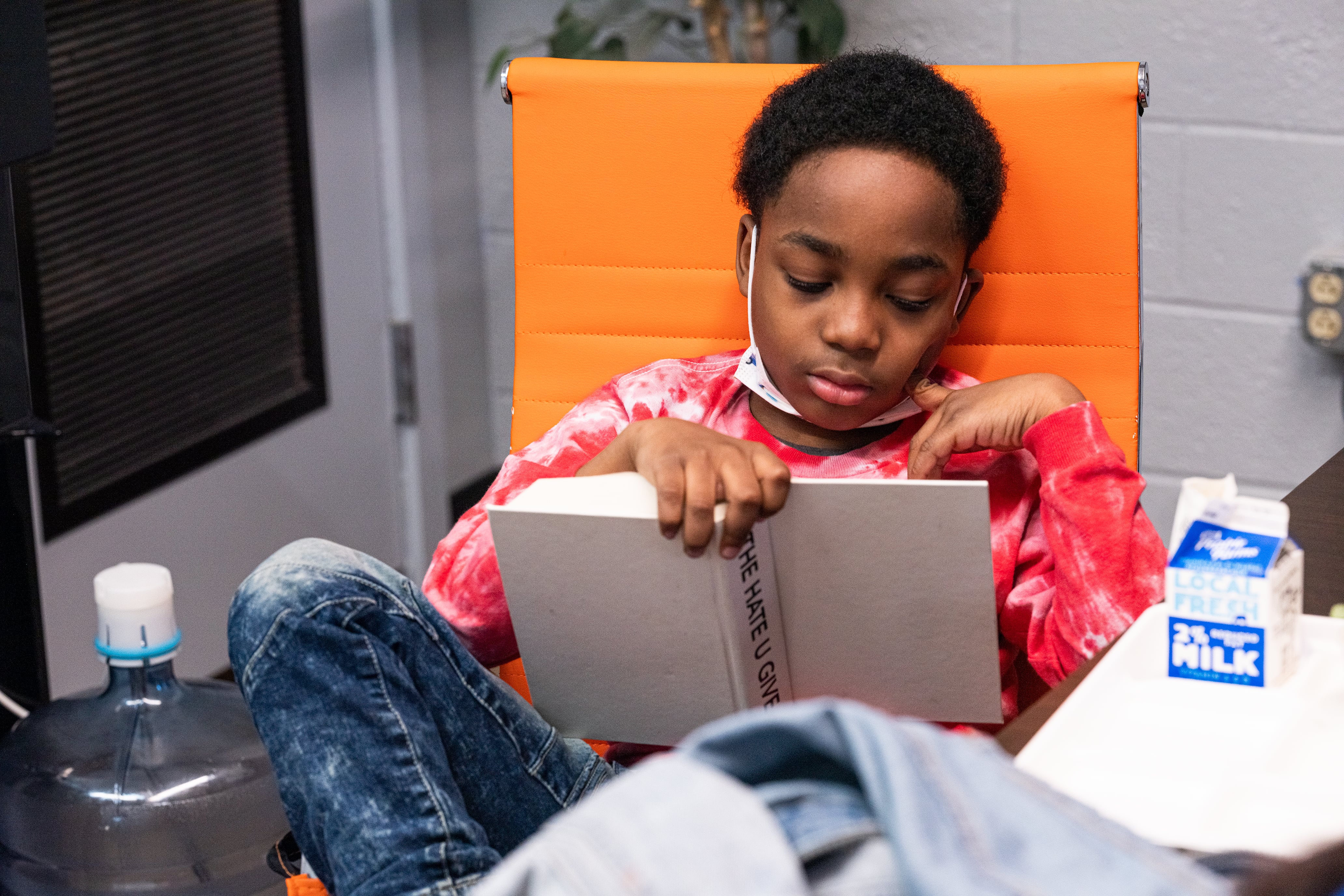Sign up for Chalkbeat Indiana’s free daily newsletter to keep up with Indianapolis Public Schools, Marion County’s township districts, and statewide education news.
Morrise Harbour has a tough assignment: turn around a chronically underperforming Indianapolis school.
When he took over in 2022, just 4% of the students at Elder Diggs School 42 achieved proficiency in English on the state ILEARN test, and just 4.3% did so in math.
Harbour, the founder of the Liberty Grove Schools, the charter school that assumed control of School 42 from Indianapolis Public Schools, began making changes slowly and steadily. It hired new staff. It adopted a trusted curriculum. It leaned into 1-on-1 instruction whenever possible.
Although the school’s proficiency scores remain relatively low, those moves appear to be producing results. This year, School 42’s ILEARN results improved for the second year in a row, with 12.1% of students reaching proficiency in English, 8.3% in math, and 4.5% in both. In fact, it’s one of several “restart” charter schools where ILEARN results improved from last year and where those scores have now surpassed pre-pandemic levels.
At these schools, a charter operator agrees to take charge of a chronically underperforming school and operates it as part of the IPS Innovation Network, in which schools get some autonomy and access to district resources.
“There’s been peaks and valleys, but a lot more highlights than lowlights over the course of these first foundational years,” Harbour said.
Overall, 2025 ILEARN results mostly remained flat or increased slightly — depending on the subject — in schools IPS runs directly, charters in the Innovation Network, and independent charters. (Innovation schools that are not charters are included in the IPS direct-run figures.)
In the schools IPS manages directly, the English proficiency rate districtwide remained essentially unchanged from last year at 20.8%, while the overall math proficiency rate increased from 19.3% to 21%, according to state data. And the percentage of students achieving proficiency in both subjects inched up from 13.5% to 14.3%. Measuring individual school success from last year is challenging, however, since the district’s decision to reconfigure grade spans at nearly all schools in the 2024-25 school year makes year-over-year comparisons imprecise.
The percentage of Black and Hispanic students in IPS-run schools reaching proficiency in both math and English increased from last year, but have not yet reached pre-pandemic levels from 2019. White students, meanwhile, continue to grow beyond pre-pandemic levels.
The latest scores for IPS still fall short of the ambitious goals set forth in its Strategic Plan 2025, which was released about five years ago and called for IPS to match the state average for ILEARN performance by this year. The district’s proficiency rates this year were below the state average IPS aimed for when the plan was crafted, as well as this year’s averages — about 41% for English, 42% in math, and 31% in both subjects.
Independent charters as a whole continued to exceed district scores for all students, with higher rates of Black and Hispanic students reaching proficiency in both subjects than those in directly run IPS schools, according to a Chalkbet analysis of state data. Nearly 16% of both Black and Hispanic students in independent charters reached proficiency in both subjects, compared to roughly 6% of Black students in IPS and 8% of Hispanic students in IPS.
Charter schools in the Innovation Network still fell below district scores overall, according to Chalkbeat’s analysis, although its students’ English and math proficiency both increased from last year.
Here are a few other takeaways from the 2025 ILEARN results.
Results suggest middle school is a challenge
The ILEARN results for IPS provide a baseline for the district’s most recent Rebuilding Stronger reorganization, which dropped middle grades from existing K-8 schools to create standalone middle schools in 2024-25.
Scores at individual schools, nearly all of which changed grade spans and many of which adopted new academic programming, were a mixed bag.
Harshman Middle School and George Julian School 57 showed the greatest year-over-year growth out of all directly run IPS schools in terms of the percentage of students reaching proficiency in both English and math. Harshman added 6th grade and became a dual language and high ability school, while School 57 dropped grades 6-8 and became an International Baccalaureate school.
District-run schools with the largest decline in the percentage of students scoring proficient in both subjects include George Washington Carver School 87, which dropped grades 6-8, and William Penn Middle School, which became a standalone middle school focused on science, technology, engineering, and math.
In a statement, the district highlighted Harshman, the Center for Inquiry at School 2, Cold Spring School, and George Julian School 47 as schools with consistent yearly increases in math since 2021.
“These results demonstrate a positive trajectory for many of our students and schools, even as we’ve navigated significant district redesign over the past two years,” Superintendent Aleesia Johnson said in the statement.
Harshman had the highest proficiency scores among middle schools and beat the districtwide average in English, math, and both subjects combined.
Proficiency rates at all other district-run middle schools fell below the districtwide average in English, math, and both subjects combined. English proficiency also declined from last year in each of the middle school grades.
There are few standalone charter middle schools. Those primarily serving grades 6-8, however, posted single-digit rates in the percentage of students scoring proficient in both subjects with the exception of Paramount Englewood, a school serving grades 5-8 with a rate of 32.5%.
Charter schools increase in math proficiency
Among 26 independent charters, English proficiency declined slightly from roughly 26.1% last year to 25.6% this year, according to state data.
Like state and districtwide results, however, math scores increased for this group from roughly 25% to 26.6%.
The share of students reaching proficiency in both subjects in independent charters has not yet reached pre-pandemic levels from 2019 — although comparisons are difficult because schools have closed and opened during that time. Schools with the biggest increases in dual proficiency since last year include the Rooted School on the eastside, which jumped from 1.9% to 10.6%, and Paramount Englewood, which increased from 25.8% to 32.5%.
Innovation charter schools increased slightly in both subjects, from 14.8% to 16.8% in English and from 13.3% to 17.5% in math.
This cohort, which changes as different operators are added to or removed from the network each year, exceeded 2019 levels of the share of students reaching proficiency in both subjects. Innovation charters with the greatest increases in dual proficiency since last year include Enlace Academy on the west side and Adelante Schools on the south side.
Most ‘restart’ and ‘emerging’ schools surpass pre-COVID scores
The new ILEARN results also show some promising signs about those schools, such as School 42, labeled as chronically underperforming by the district.
For example, seven of the eight restart schools grew in the share of students reaching proficiency in both English and math since last year, with six of them exceeding pre-pandemic levels from 2019. A seventh restart charter school (that combined two schools into one), Adelante Schools at Emma Donnan, increased in dual proficiency over last year, with 16.5% of students proficient, compared to 5% in its first year of operation.
Results for schools designated by the district as “emerging” in 2020-21 — those that are chronically underperforming – are mixed. Of the remaining 11 schools designated as “emerging” at that time, five have exceeded pre-pandemic levels in the share of students scoring proficient in both math and English, including Brookside School 54, Charles Warren Fairbanks School 105, Eleanor Skillen School 34, Harshman Middle School, and Ralph Waldo Emerson School 58. Comparisons are difficult, however, because most of the schools now serve different grade spans.
At Liberty Grove, Harbour has embraced community partnerships, such as the Circle City Readers tutoring program, to give students more individualized attention. The school also built in a dedicated time period for 1-on-1 interventions at least two to three times a week, Harbour said.
“We focused on, ‘OK, if you’re a student at Liberty Grove schools, where were you three, six, eight weeks ago before you took this interim assessment?’ And then we said, ‘OK, this is where you are. This is where you want to be.’”
In the next few years, Harbour hopes to be reaching proficiency rates of 30% or more. But he doesn’t expect that to happen quickly.
“I try to emphasize this: It takes time,” he said.
Amelia Pak-Harvey covers Indianapolis and Lawrence Township schools for Chalkbeat Indiana. Contact Amelia at apak-harvey@chalkbeat.org.






